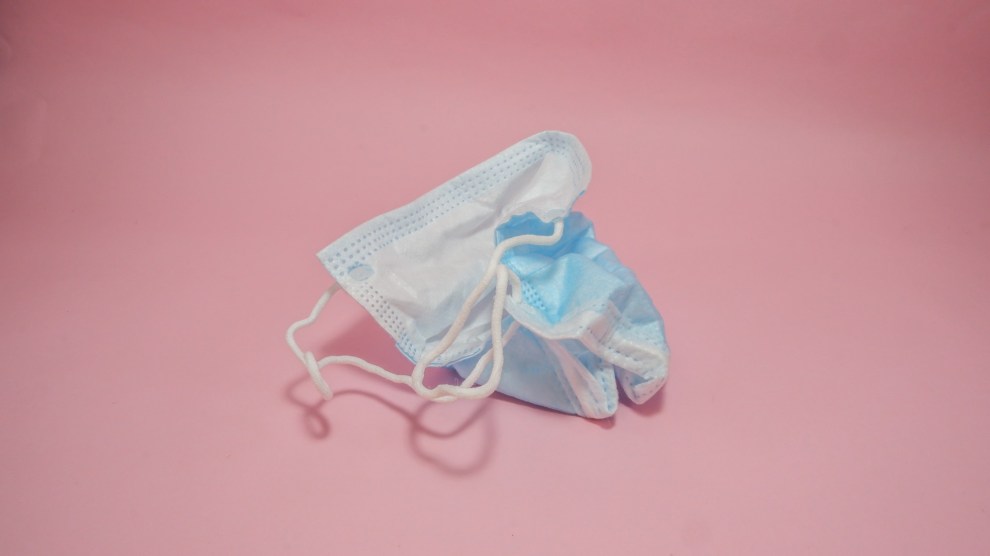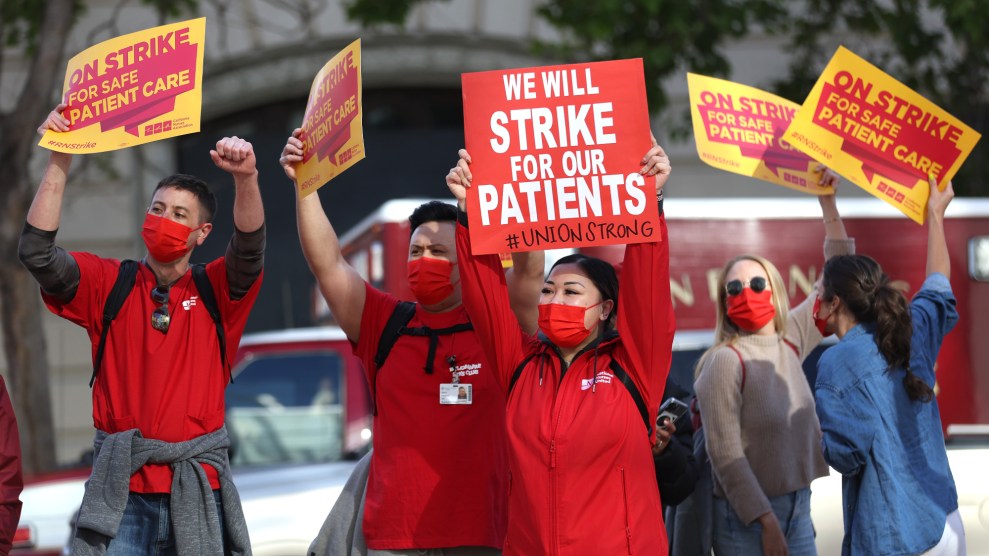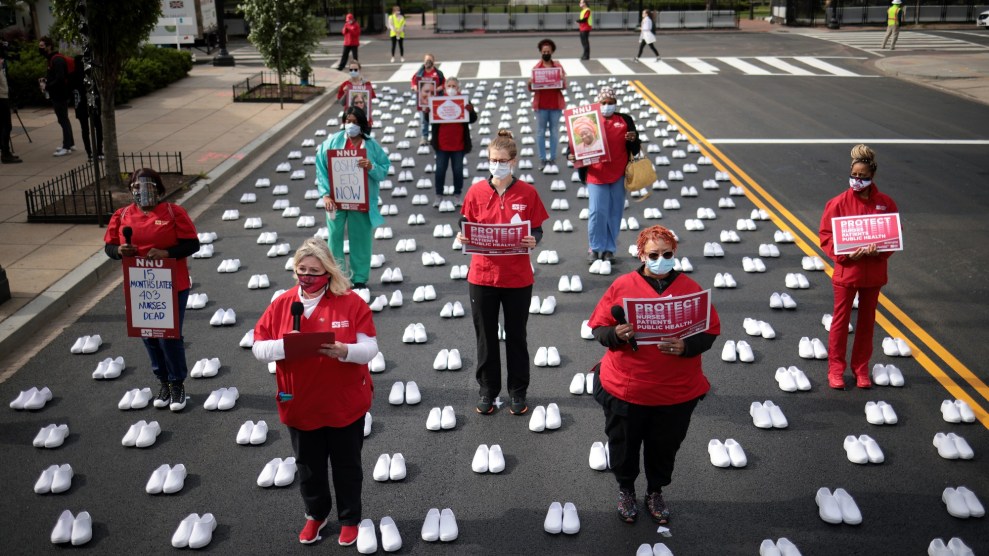
Christiane Lois Dating/Getty
Update, May 2: After a week on strike, the union representing nurses at Stanford Health Care and Lucile Packard Children’s Hospital voted to approve a new three-year contract with the hospitals and will return to work on May 3.
After a brutal two years on the front lines of the pandemic, nurses at Stanford’s hospitals are on the verge of a strike. As my colleague Emily Hofstaedter reported last week, the nurses’ union, which represents nurses at Stanford Health Care and Lucile Packard Children’s Hospital, are demanding better mental health care, staffing support, higher wages, and more vacation time to combat the burnout that has affected an alarming number of those in the profession nationwide. In response to the threat of a strike, the hospital said it would suspend health care for nurses who participate.
Without an agreement with the hospital, the union said it plans to strike beginning on Monday. In the days ahead of the planned strike, following a flurry of media coverage, the hospital scheduled a formal bargaining session on Tuesday, the Mercury News reports.
In a statement provided to Mother Jones via email, Chief Nurse Executive and Vice President of Patient Care Services for Stanford Health Care Dale Beatty said the hospital has “proposed highly competitive contract terms,” including “market-leading pay” and measures meant to enhance “nurse staffing and wellness.” “While we respect our nurses’ rights to engage in this work action,” the statement reads, “we are disappointed that the union has chosen to strike.”
As negotiations continue, Mother Jones spoke to a nurse who works in the pediatric ICU at Lucile Packard Children’s Hospital Stanford about the working conditions leading up to this moment. Below, she describes in her own words what understaffing in her unit actually looks like, and how, on top of that, she and her colleagues have seen an unbearable number of child deaths in the last year, both due to Covid and not.
Due to concern about retaliation, she asked to remain anonymous. Her account has been edited and condensed for clarity.
Initially, we didn’t get hit that hard by Covid. We were totally prepared for adult overflow. They asked members of the staff, “Hey, if we get adult ICU overflow patients, who would be willing to take care of them?” So I volunteered for that. We made one whole floor of the ICU our Covid ICU. Initially, we were really overstaffed. So we were ready for things to be a lot worse than they were for us at the beginning. Covid just didn’t really seem to get kids that sick. The kids that got sick tended to be teenagers.
Towards the end of the summer of 2020, I think there was just the right combination of things: They started doing elective surgeries again, they started doing clinic visits again, and some people changed units or quit or went on leaves of absence. So starting in maybe July or August of 2020, we started being short-staffed. We have been perpetually short-staffed since then. There are times when they’re sending out text messages saying 10 open shifts, and you have managers begging you, “Hey, can you come in for any amount of time today?” So it’s been an interesting roller coaster, where at first we’re thinking, “Gosh, we’re so overstaffed,” to the other direction, being understaffed and drowning, barely keeping our heads above water.
I think once we swung to that other direction, and started becoming short-staffed and having a unit full of really sick patients, I think that’s when I started feeling burned out. And to have our hospital not address it—and continue the classic, “Well, here’s some pizza”—it has been really, really frustrating. Historically speaking, we have peaks and valleys in our patient census throughout the year. And the fact that we’ve just been at a constant peak for so long, it’s really hard to feel like you’ll get any type of reprieve.
I remember being at work, and someone telling me about [the suicide of a Stanford nurse earlier this year]. We discussed it in the break room for a little bit, but then I had to go back to work. I kind of had to put it out of my head. I couldn’t sit there and process it because I had patients to take care of. I think it’s a common feature, as a caregiver, as a health care worker, to put yourself and your needs on the backburner. And you can only do that for so long before it catches up with you.
There can be a lot of trickle-down consequences of being understaffed. For instance, if you have two patients who are really sick, and you find yourself drowning, you can’t really provide good care to either of them. You can’t be in two places at once. Another thing that can happen is, if you have a really sick patient—someone who’s intubated, on a ventilator, could be on continuous dialysis, could be on ECMO—and if we’re understaffed, you don’t have anybody to help you if that patient crashes. You may need five people in there, but you’re one person. You can really only do one thing at a time. So a lot of times when we’re understaffed, I think that it’s detrimental to our patients. I feel like we’re sacrificing the quality of our care. And in some instances, putting ourselves and our patients in situations that aren’t safe.
On our unit, we’re also hemorrhaging skilled staff. They’re going to other units, where they won’t have to work as hard, essentially. And we’re replacing a lot of these skilled staff members who have been there five, seven years with brand new people who have no ICU experience. And when you’re understaffed, you have to be independent and ask for help from your neighbors. And these new staff members, they can’t help their neighbors. They need someone to help them.
So after some of those nights where I don’t sit down, I can’t find anybody to help me, I’ll find myself thinking, “Why am I working this hard? Why don’t I go to a different unit where I can make the same amount of money and have it be better staffed?”
[Editor’s note: The statement from Stanford’s Dale Beatty reads, “We have made significant investments in nurse staffing in recent years, even as many hospitals face unprecedented staffing challenges. At Stanford Health Care, the clinical nurse population has increased by 36% over the last three years; during the same period at Lucile Packard Children’s Hospital our clinical nursing workforce increased by 24.5%. That’s an increase of nearly 1,200 nurses across both hospitals since January 2019.”]
One of the things I’ve learned to do [for my mental health], is to separate myself from things that happen at work. It makes me sad, but sometimes I’m very impersonal with patients. If parents are in the room, for example, and they want to show me a video of what their kid looked like when they were healthy and happy—I know it sounds terrible, but I don’t look. It’s too hard for me. They’re my patient right now. I see them in their current state. I detach myself. That’s how I am able to keep doing this work.
Last year was a really hard year. We had a lot of deaths. There was one patient in particular that hit the unit really hard. She was school-aged, and was first admitted with some type of liquid cancer, like lymphoma or leukemia. She was really sick, and she was with us for a long time. But then, she actually started to get better. She got to go home, and she was being seen on a sort of outpatient basis.
Then, later on, she got readmitted with Covid. And we fought really, really hard. She was back in our unit for at least a month. And one night, she coded. We tried to resuscitate her for 40 minutes—which is a long time to do CPR on somebody—before we finally called it.
She was someone that everybody loved. Any night that I took care of her, I had three or four nurses coming by the room to visit and say hi and see how she was doing. And her mom was just the sweetest person. And the thing is, when you have Covid like that, your caregiver can’t leave the room. So her mom was trapped in that room with her for 30 days. It was devastating.
Not all of the deaths last year were Covid patients. Some were tough just because they had been with us for months and months. It’s really hard to fight for that long, to watch them suffer, to watch them struggle. And in the end, to put them in a body bag. I know that several people who have left over the last year have said, “Look, I put too many kids in body bags this year. I can’t do this anymore.”
I know people who have changed units and are much happier. I’ve thought about it, but haven’t gone so far as to submit an application for another job. I think I’m still hoping that it gets better.
I voted in favor of authorizing the strike. It’s very disappointing to be called health care heroes, and have all of this verbal praise lavished on us for the last two years, and then when it comes time to actually follow up those lovely sentiments with actions, it’s not there. And people are fed up with it. It’s time to put your money where your mouth is. So for me, it was an easy decision to say yes, if it comes to it, and our union leadership thinks we need to strike, I’m all for that.
The vibe [among nurses] at work is that Stanford thinks we have it good enough, and they don’t need to make it any better. They’ve got deep pockets, so they’re just going to try to ride us out. On April 15, the hospital said that they would terminate health care benefits for striking nurses as of May 1. I’m currently on a medical leave of absence, and I will be able to keep my health insurance for now. So I feel really lucky and really fortunate. But if we are still striking into June, after my leave is over, I’m not so sure. I would have to probably look at purchasing my own health insurance.
In many ways, we do have it very good in California. There are state-mandated [nurse-to-patient] ratios, there are unions, if you don’t get your breaks there are consequences. I talk to my friends out on the East Coast, and most of the time, they say, “Oh, I’m lucky if I can beg someone to watch my patients for 10 minutes so I can go to the bathroom and eat a doughnut.” And people in other places are like, “Well, you guys have it good compared to what we have.” But I still don’t think that means we can’t ask for more. You don’t have to accept something just because that’s the way it’s always been.
This story has been updated.












